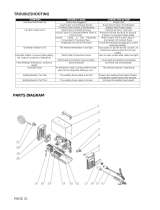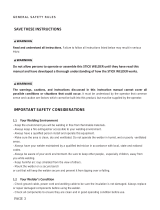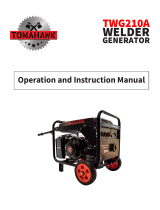
SAFETY iNSTRUCTiONS TO OPERATOR
For your own protection, read and observe all instructions
mcluded nn this manual as well as the following specific
safety precautions.
1. PROTECTION FROM ELECTRICAL SHOCK
a. Do not let bare skin or wet clothing come between
the following combnnatlons
Electrode and Electrode Holder
Work Clamp Work Piece Metal Work Table
80 volts exast between these parts
when welder is onq I
Wear dry hole-free, clothing, gloves and shoes to
protect and insulate the body.
b Take special care to insulate yourself from ground
using dry =nsulatuon (such as dry wood} of adequate
s=ze when welding m damp Iocat,ons, on metal floors
or gratings, and in positions (such as s_tting or lying)
where parts or large areas of your body can be in
contact w_th possible grounds.
c. Manntain the electrode holder, work clamp, welding
cable and welding machine in good, safe operating
condition.
d. Do not use welding electrode as a cigarette hghter
e Connect the welder only to a source of electrical
power meeting the requ,rements, including
grounding, of the National Electrical Code (ANSI C1)
and local codes
f. Electrode coating may be eleetncaUy conductnve-
use welding gloves when ehangnng electrodes.
2. EYE AND BODY PROTECTION
a Use helmet, filter, and cover plate complytng with
ANSI Z87 1 to protect your eyes and face from
sparks and the rays of the arc when welding or
obserwng open arc weld=rig
b Always wear safety goggles with side shields
complying with ANSI Z87 1 when Jn a welding area,
or when near slag chipping operation
c. Wear od free protective garments, such as leather
gloves, heavy shirt, cuffless trousers and high shoes
d. Protect other near-by personnel w_th suitable
non flammable screening.
e Provide ddequdte ventilation in the welding area,
particularly when welding on galvanized, lead or
cadmeum plated steel, and other metal whtch produce
toxic fumes
f When worktng above floor level, protect yourself
from a fall should you get a shock. Never wrap the
electrode cable around any part of your body
g Do not weld m Iocat=ons close to chlorinated
hydrocarbon vapors com=ng from degreasmg.
cleaning, or sprawng operations The heat of the rays
of the arc can react with solvent vapors to form
phosgene, a highly toxic gas, and other irritating
products.
h. Unprotected specators must be kept clear of the
welding area doe to the harmful nature of ultra-wolet
and infra-red arc rays, welding sparks, and welding
fumes and gases
3. FLAMMABLE AND EXPLOSIVE MATERIALS
a. Remove flammable and explosive mater_al at least 35
feet from the welding arc to prevent welding sparks
or molten metal from starting a fire. Keep a type
ABC f_r_ extinguisher within easy reach
b,
Welding on or near containers wh,ch hold combustibles
can cause an expiosmn, even when they have been
cleaned For =nforn_atcon purchase "Safe Practtces for
Welding and Cutting Containers that Have Held
Combustrbles" (A6.0-65} from the Amerfcan Welding
Society 2501 Northwest Seventh St, Mnam_ FJorlda
33125
C.
When not welding, place the electrode holder where it
is _nsulated from the work clamp, work p=ece, or
work table. Accidental grounding can cause
overheating of the cables and wetder, creating a fire
hazard
d
Never connect the work cable or clamp to any object
but the work piece or metal work table. Connectnng
to other objects such as budding ground can create a
fire hazard
4. PREVENTATIVE MAINTENANCE
a,
Never apply power to the welder wnth any part of the
"cabinet" removed. Position on-off switch in "Off"
posltnon and disconnect welder from the power
supply before donng maintenance work inside the
machine. Removal of the welder cabinet should be
done only by a qualifned servnce techmcran
b. Before connecting the welder power cord to the
receptacle, check the following
1 Inspect the power cord and welding cables for cuts
or burns and make sure blades and ground pm on
the plug are stranght
2 Inspect "On-Off" sw_tch fever for cracks or broken
parts.
3 Inspect electrode holder law insulators for cracks
or broken parts
e. Never weld anything on or to the welder cabinet, as a
burn through may cause transformer failure
d
For additional safety information, purchase copies of
"Practice for Occupational and Educational Eye and
Face Protection" (ANSI Z87.1), "Safety _n Welding
and Cutting" (ANSI Z49.1), and "F_re Protection in
Use of Welding and Cutting Processes" (ANSI'NFPA
No 51B) from the Amerncan Natnonal Standards
[nstntute, 1430 Broadway, New York, N Y 10018
2






















